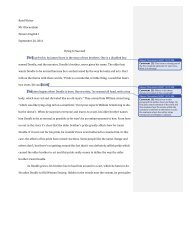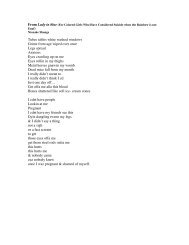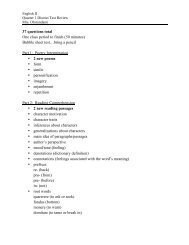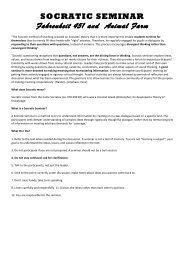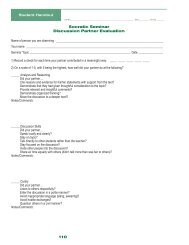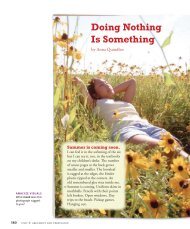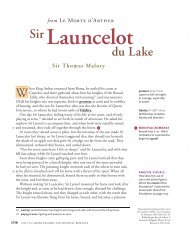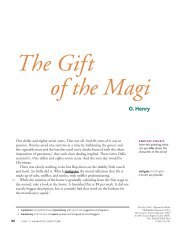The Language of Poetry - LanguageArts-NHS
The Language of Poetry - LanguageArts-NHS
The Language of Poetry - LanguageArts-NHS
You also want an ePaper? Increase the reach of your titles
YUMPU automatically turns print PDFs into web optimized ePapers that Google loves.
poetic form: sonnet<br />
<strong>The</strong> sonnet has been a popular poetic form for centuries, and,<br />
traditionally, love has been its subject. While different types <strong>of</strong><br />
sonnets have been developed by various poets, there are some<br />
characteristics that are common to all sonnets.<br />
• Typically, the sonnet is a 14-line lyric poem written with a<br />
strict pattern <strong>of</strong> rhyme and rhythm.<br />
• <strong>The</strong> English, or Shakespearean, sonnet has a rhyme scheme<br />
<strong>of</strong> abab cdcd efef gg. Notice how this divides the poem into<br />
four distinct line groups: three quatrains, or four-line units,<br />
followed by a couplet—a pair <strong>of</strong> rhymed lines, or two-line unit.<br />
• <strong>The</strong> meter, or the repeated pattern <strong>of</strong> rhythm, in each line<br />
<strong>of</strong> a sonnet is typically iambic pentameter. Each rhythmic<br />
unit <strong>of</strong> meter is known as a foot. <strong>The</strong> most commonly used<br />
metrical foot is an iamb, which is an unstressed syllable<br />
followed by a stressed syllable. Note the iambs in the<br />
following example from Shakespeare’s “Sonnet 18”:<br />
So long as men can breathe, or eyes can see,<br />
So long lives this, and this gives life to thee.<br />
In each line, notice that there are five units <strong>of</strong> iambs. When a<br />
line has five feet in it, it is referred to as pentameter. <strong>The</strong>refore,<br />
this meter is called iambic pentameter.<br />
As you read the poems in this lesson, compare their rhyme<br />
schemes and meter.<br />
reading strategy: reading sonnets<br />
Through their structure, sonnets <strong>of</strong>ten express complex ideas.<br />
<strong>The</strong>se strategies will help you better understand sonnets:<br />
1. Identify the situation, problem, or question introduced at the<br />
beginning <strong>of</strong> the poem.<br />
2. Identify the turning point, if there is one.<br />
3. Determine how the situation is clarified, the problem<br />
resolved, or the question answered.<br />
As you read, apply these strategies and record the results on a<br />
chart like the one shown.<br />
Strategy<br />
Situation/Problem/Question<br />
Turning Point<br />
Solution/Resolution/Answer<br />
Sonnet 18 Sonnet XXX<br />
William Shakespeare:<br />
Renaissance Man<br />
Although Shakespeare<br />
is best known for his<br />
plays, he was also a<br />
brilliant poet. When<br />
Shakespeare began his<br />
career in the 1590s, the<br />
sonnet was a literary<br />
fashion in England,<br />
usually written as<br />
William Shakespeare<br />
1564–1616<br />
a longing tribute to<br />
a faraway beloved.<br />
In fact, many <strong>of</strong> Shakespeare’s sonnets<br />
are addressed to a “dark lady” whose<br />
identity has never been discovered. First<br />
published in 1609, the complete series <strong>of</strong><br />
154 sonnets includes some <strong>of</strong> the finest love<br />
poems written in English. For more about<br />
Shakespeare, see the extended biography on<br />
page 1084.<br />
Edna St. Vincent Millay:<br />
A True Original Edna<br />
St. Vincent Millay<br />
was only 19 when her<br />
poem “Renascence”<br />
made her an instant<br />
celebrity. Although<br />
Millay’s youth and freespirited<br />
lifestyle fit the<br />
image <strong>of</strong> the rebellious<br />
artist, her highly<br />
crafted poems <strong>of</strong>ten<br />
took on traditional<br />
Edna St. Vincent Millay<br />
1892–1950<br />
poetic forms, such as the sonnet. In 1923 she<br />
became the first woman to win the Pulitzer<br />
Prize in poetry, a tribute to her technical skill.<br />
more about the author<br />
For more on William Shakespeare<br />
and Edna St. Vincent Millay, visit the<br />
Literature Center at ClassZone.com.<br />
sonnet 18 / sonnet xxx 729



